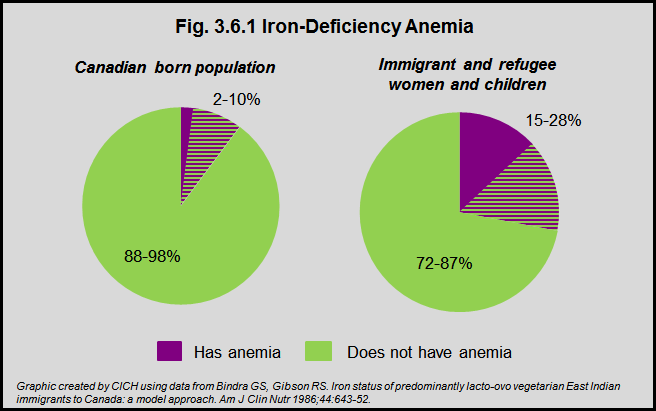Iron-Deficiency Anemia

Anemia is a condition where the blood lacks adequate healthy red blood cells that carry oxygen to the tissues of the body. Iron-deficiency anemia is due to a lack of iron. It is the most common kind of anemia and the most common nutritional illness in the world. Iron-deficiency anemia can result in poor pregnancy outcomes and impaired physical and cognitive development in children. No routine iron-deficiency screening or supplementation program is offered in Canada for immigrants, either before or after their arrival.1 Immigrant and refugee women and children have a higher prevalence of anemia (15%–28%) than the Canadian-born population (2%–10%), excluding First Nations populations.2 According to the World Health Organization the prevalence of iron-deficiency anemia among preschool children ranges from 21% to 68% and for women of childbearing age it is 18% to 48%.3 It can occur for several reasons including intestinal parasitic infections, dietary iron deficiency, menstrual blood loss, and pregnancy. Immigrants and refugees coming from regions with limited access to iron-rich foods, higher rates of infectious disease and higher numbers of births are at risk for iron deficiency.
Implications
Canadian Immigrant Health Guidelines recommend that to improve their cognitive development, growing children aged one to four years should be screened for iron deficiency by means of hemoglobin measurement. They also recommend that to improve hemoglobin levels and work productivity, immigrant and refugee women of reproductive age should also be screened by means of hemoglobin measurement.
1Pottie K, Greenaway C, Feightner J, et al. Evidence-based clinical guidelines for immigrants and refugees. CMAJ 2011;183:E824-925.
2Bindra GS, Gibson RS. Iron status of predominantly lacto-ovo vegetarian East Indian immigrants to Canada: a model approach. Am J Clin Nutr 1986;44:643-52.
3World Health Organization. Worldwide prevalence of anaemia 1993–2005. Geneva (CH): The Organization; 2008. Available: http://whqlibdoc.who.int/publications/2008/9789241596657_eng.pdf (accessed 2008 Sept. 10).
